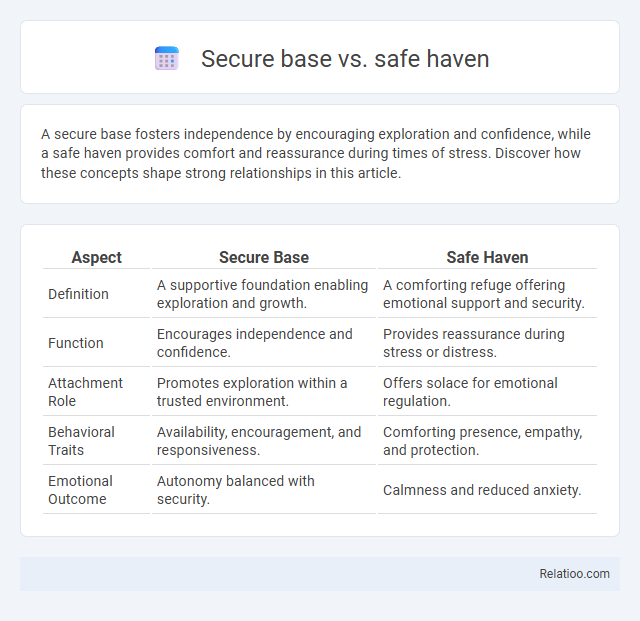A secure base fosters independence by encouraging exploration and confidence, while a safe haven provides comfort and reassurance during times of stress. Discover how these concepts shape strong relationships in this article.
Table of Comparison
| Aspect | Secure Base | Safe Haven |
|---|---|---|
| Definition | A supportive foundation enabling exploration and growth. | A comforting refuge offering emotional support and security. |
| Function | Encourages independence and confidence. | Provides reassurance during stress or distress. |
| Attachment Role | Promotes exploration within a trusted environment. | Offers solace for emotional regulation. |
| Behavioral Traits | Availability, encouragement, and responsiveness. | Comforting presence, empathy, and protection. |
| Emotional Outcome | Autonomy balanced with security. | Calmness and reduced anxiety. |
Understanding Secure Base and Safe Haven Concepts
Understanding the secure base and safe haven concepts is crucial for fostering healthy relationships and emotional resilience. A secure base provides a supportive environment encouraging exploration and growth, while a safe haven offers comfort and protection during times of distress. Recognizing how these roles function can enhance your ability to build trust and emotional security with others.
Attachment Theory: Foundations of Secure Base and Safe Haven
Attachment Theory identifies the secure base as the caregiver's reliability that enables exploration and autonomy, while the safe haven provides comfort and protection during distress. The secure base fosters confidence in exploring the environment, reinforcing secure attachment through consistent availability. In contrast, the safe haven function addresses moments of threat or anxiety, ensuring emotional regulation and security within the caregiver-child relationship.
Key Differences Between Secure Base and Safe Haven
A secure base provides You with a foundation for exploration and growth, encouraging independence and confidence in new experiences. A safe haven offers immediate comfort and protection during times of distress, focusing on emotional support and reassurance. The key difference lies in their functions: the secure base fosters autonomy and risk-taking, while the safe haven centers on soothing and recovery from stress.
The Role of Secure Base in Emotional Development
The secure base plays a crucial role in emotional development by providing a foundation from which individuals can explore their environment with confidence and resilience. Unlike a safe haven, which offers comfort and protection during distress, the secure base supports autonomy and growth, allowing Your emotional security to expand through exploration and learning. This dynamic fosters emotional regulation, self-esteem, and social competence, essential components in healthy psychological development.
Safe Haven: Providing Comfort During Distress
Safe haven functions as an emotional refuge, offering immediate comfort and reassurance during times of distress, which helps regulate negative emotions and restore a sense of security. Unlike the secure base, which encourages exploration and independence, the safe haven emphasizes proximity and support when an individual feels threatened or overwhelmed. This dynamic ensures psychological resilience by allowing individuals to seek solace and recover before reengaging with challenges.
Secure Base vs Safe Haven in Parent-Child Relationships
In parent-child relationships, a secure base refers to the caregiver's role in providing a reliable foundation from which the child can explore the world, fostering independence and confidence. A safe haven emphasizes the caregiver's ability to offer comfort and protection when the child feels threatened or distressed, ensuring emotional security. Understanding the dynamic between secure base and safe haven clarifies how attachment behaviors support both exploration and emotional regulation in child development.
Manifestations in Adult Relationships
In adult relationships, a secure base manifests as confidence in exploring personal growth and pursuing individual goals, supported by a partner's consistent availability and encouragement. A safe haven is evident when partners provide comfort, reassurance, and emotional support during moments of stress or vulnerability, fostering trust and emotional security. Secure base behavior promotes autonomy within the relationship, while safe haven behavior reinforces emotional closeness, both critical for healthy adult attachment dynamics.
How Secure Base and Safe Haven Impact Attachment Styles
Secure base and safe haven functions are foundational in shaping attachment styles, with a secure base promoting exploration and confidence, while a safe haven provides comfort during distress. A caregiver serving as a secure base encourages autonomy and resilience, leading to secure attachment, whereas a reliable safe haven helps regulate emotions and alleviates anxiety, reinforcing trust and security. Inconsistent or unavailable secure base and safe haven support often contributes to anxious or avoidant attachment patterns, highlighting their critical role in emotional development.
Enhancing Secure Base and Safe Haven in Everyday Life
Enhancing a secure base involves fostering consistent support and encouragement that empowers individuals to explore and grow confidently, while promoting emotional resilience through reliable presence. Developing a safe haven requires creating an environment of unconditional acceptance and comfort where one can return for reassurance during stress or distress. Integrating both concepts in daily interactions strengthens attachment security by balancing autonomy with emotional safety, leading to healthier relationships and improved psychological well-being.
Practical Tips for Nurturing Secure Attachment
Establishing a secure base means consistently providing your child with reliable support and encouragement to explore their environment confidently. Creating a safe haven involves being emotionally available and responsive when your child seeks comfort during times of distress. To nurture secure attachment, you should practice sensitive listening, offer consistent reassurance, and respond promptly to your child's needs, fostering a trustworthy and supportive relationship.

Infographic: Secure base vs Safe haven
 relatioo.com
relatioo.com